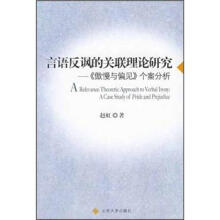言语反讽的关联理论研究:《傲慢与偏见》个案分析

目 录内容简介
Chapter 1 Introduction
1.1 Facts and questions about verbal irony
1.2 Rationale of the present study
1.3 Objectives of the present study
1.4 Methodology, terminology and data
1.5 Outline of the book
Chapter 2 Literature Review of Verbal Irony
2.1 Semantic study of verbal irony
2.2 Pragmatic study of verbal irony
2.2.1 Grice's theory of verbal irony
2.2.2 Verbal irony as insincere speech act
2.2.3 Leech's view of verbal irony
2.2.4 Brown and Levinson's view of verbal irony
2.3 Psycholinguistic study of verbal irony
2.3.1 Gibbs's direct access view of verbal irony
2.3.2 Giora's graded salience hypothesis
2.4 Summary
Chapter 3 Theoretical Framework of the Present Study
3.1 Relevance theory and discourse understanding
3.1.1 Relevance theory
3.1.2 Relevance-theoretic approach to context
3.1.3 Utterance understanding and poetic effects
3.2 Understanding ironic utterances within the relevance-theoretic framework
3.2.1 Echoic-interpretation theory of irony
3.2.2 Yus's model of irony comprehension
3.3 Applications of the relevance-theoretic approach to the analysis of literary texts
3.4 Summary
Chapter 4 Contextual Activation in the Relevance-Theoretic Framework and Verbal Irony in Pride and Prejudice
4.1 Encyclopedic, factual information
4.1.1 Macrosocial norms and factual information
4.1.2 Commonsense assumptions
4.1.3 Microsocial situational expectations
4.2 Mutually manifest physical environment(setting)
4.3 Speaker's nonverbal behavior
4.4 Addressee's background knowledge of addresser's biographical data
4.5 Mutual knowledge
4.6 Previous utterances in the conversation
4.7 Linguistic cues
4.8 Summary
Chapter 5 Criterion of Optimal Accessibility to Irony and Verbal Irony in Pride and Prejudice
5.1 Prototypicat case 1 : fast identification of dissociation
5.1.1 Verbal irony in the conversations between the characters
5.1.2 Verbal irony in the narrations of the narrator
5.2 Prototypical case 2 : slow identification of dissociation
5.3 Prototypical case 3: nonexistent identification of dissociation
5.4 Summary
Chapter 6 Poetic Effects in the Relevance-Theoretic Framework and Verbal Irony in Pride and Prejudice
6.1 Satirical humorous effect
6.1.1 Lexical cues
6.1.2 Syntactic cues
6.1.3 Stylistic cues
6.2 Joyous and cordial effect
6.3 Vigilant effect
6.4 Summary
Chapter 7 Conclusion
7.1 Summary of findings
7.2 Limitations of the present study
7.3 Suggestions for further research
Bibliography
1.1 Facts and questions about verbal irony
1.2 Rationale of the present study
1.3 Objectives of the present study
1.4 Methodology, terminology and data
1.5 Outline of the book
Chapter 2 Literature Review of Verbal Irony
2.1 Semantic study of verbal irony
2.2 Pragmatic study of verbal irony
2.2.1 Grice's theory of verbal irony
2.2.2 Verbal irony as insincere speech act
2.2.3 Leech's view of verbal irony
2.2.4 Brown and Levinson's view of verbal irony
2.3 Psycholinguistic study of verbal irony
2.3.1 Gibbs's direct access view of verbal irony
2.3.2 Giora's graded salience hypothesis
2.4 Summary
Chapter 3 Theoretical Framework of the Present Study
3.1 Relevance theory and discourse understanding
3.1.1 Relevance theory
3.1.2 Relevance-theoretic approach to context
3.1.3 Utterance understanding and poetic effects
3.2 Understanding ironic utterances within the relevance-theoretic framework
3.2.1 Echoic-interpretation theory of irony
3.2.2 Yus's model of irony comprehension
3.3 Applications of the relevance-theoretic approach to the analysis of literary texts
3.4 Summary
Chapter 4 Contextual Activation in the Relevance-Theoretic Framework and Verbal Irony in Pride and Prejudice
4.1 Encyclopedic, factual information
4.1.1 Macrosocial norms and factual information
4.1.2 Commonsense assumptions
4.1.3 Microsocial situational expectations
4.2 Mutually manifest physical environment(setting)
4.3 Speaker's nonverbal behavior
4.4 Addressee's background knowledge of addresser's biographical data
4.5 Mutual knowledge
4.6 Previous utterances in the conversation
4.7 Linguistic cues
4.8 Summary
Chapter 5 Criterion of Optimal Accessibility to Irony and Verbal Irony in Pride and Prejudice
5.1 Prototypicat case 1 : fast identification of dissociation
5.1.1 Verbal irony in the conversations between the characters
5.1.2 Verbal irony in the narrations of the narrator
5.2 Prototypical case 2 : slow identification of dissociation
5.3 Prototypical case 3: nonexistent identification of dissociation
5.4 Summary
Chapter 6 Poetic Effects in the Relevance-Theoretic Framework and Verbal Irony in Pride and Prejudice
6.1 Satirical humorous effect
6.1.1 Lexical cues
6.1.2 Syntactic cues
6.1.3 Stylistic cues
6.2 Joyous and cordial effect
6.3 Vigilant effect
6.4 Summary
Chapter 7 Conclusion
7.1 Summary of findings
7.2 Limitations of the present study
7.3 Suggestions for further research
Bibliography
目 录内容简介
《言语反讽的关联理论研究:〈傲慢与偏见〉个案分析》是在关联理论取得的研究成果的基础上,以言语反讽作为个案,综合地解释了反讽用法所基于的生成和运作机制以及它可能产生或意欲获得的交际效果,从而充分地揭示了反讽意义的丰富性、功能的多样性以及用法的复杂性。其研究焦点集中在文学文本中的反讽话语的理解上。
比价列表
公众号、微信群
 缺书网
缺书网微信公众号
 扫码进群
扫码进群实时获取购书优惠






